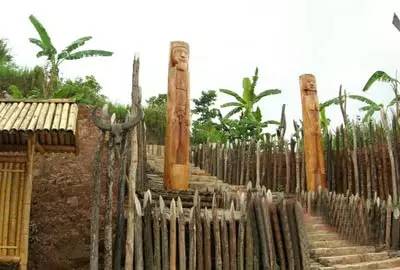
Yongluoke Wooden Drum Garden in Ximeng County, Puer
Overview
The Yongluoke Wooden Drum Garden (永克洛园, Yǒngkèluò Yuán) showcases the sacred wooden drum, a symbol of the Wa (佤族, Wǎzú) people. The name “Keluò” in the Wa language refers to “Wooden Drum House” or “Wooden Drum Village.” This themed park features hundreds of wooden drums displayed within wooden drum houses, creating a rhythmic drum cluster for visitors. Here, you can see the largest collection of wooden drums in the world, including the largest wooden drum, as well as sculptures of the Wa guardians, towering ox head posts, bull-catching posts, vine bridges, mysterious human head posts, and the monument for “The Wa People Sing New Songs” (阿佤人民唱新歌, Ā Wǎ Rénmín Chàng Xīn Gē). This song was composed by Yang Zhenren (杨振仁) in the original Mowu Township (莫窝乡) of Ximeng County and is based on the folk song “White Egrets” (白鹇鸟, Bái Xiān Niǎo), serving as the county song of Ximeng Wa Autonomous County (西盟佤族自治县, Xīméng Wǎzú Zìzhìxiàn).
Cultural Context
Ximeng Wa Autonomous County is part of Pu’er City (普洱市) in the southwest of Yunnan Province (云南省). It is located in the Awa Mountain (阿佤山, Āwà Shān) area, which is rich in wild tea resources and is home to the Wa people, one of the earliest ethnic groups to inhabit this mountainous region. The area also celebrates various vibrant festivals, including the Gourd Festival (葫芦节, Húlu Jié) and the New Rice Festival (新米节, Xīnmǐ Jié).
The wooden drum, known as a unique type of drum among China’s 56 ethnic groups, is a sacred instrument for the Wa people, often associated with matriarchal society and reproductive worship. Festivals such as the Wooden Drum Festival, New Fire Festival, New Water Festival, and New Rice Festival are marked by the playing of drums, singing, and dancing.
Attractions
In addition to the wooden drum exhibits, the garden features various attractions, including:
- Revolutionary Martyrs’ Cemetery (西盟革命烈士陵园, Xīméng Gémìng Lièshì Língyuán): Built to honor the martyrs who bravely sacrificed their lives in battles during the liberation of the Awa Mountains.
- Sacred Sites: The Mengsuo Dragon Pool (勐梭龙潭, Mèngsuǒ Lóngtán) and Li Kan Waterfall (里坎瀑布, Lǐkǎn Pùbù) are natural attractions connected to local beliefs and the worship of nature.
- Vine Bridge (藤索桥, Téngsuǒ Qiáo): Known as the ancestor of modern bridges, this stunning structure exemplifies Wa craftsmanship.
Nearby Cultural Experiences
- Buddhist Temples: The Shangcheng Buddha Temple (上城佛寺, Shàngchéng Fósì), also known as Jing’er Temple (景儿), is a cultural center for the Dai (傣族, Dǎizú) community and showcases their art and architecture.
- Ethnic Villages: The Bohang Wa Ecological Village (博航佤族生态村, Bóháng Wǎzú Shēngtài Cūn) offers insights into Wa religious beliefs and traditions, making it an excellent spot for cultural exploration.
- Caves: The region features several natural caves, such as Mowu Cave (莫窝溶洞, Mòwō Róngdòng) and Dailagala Cave (歹格拉溶洞, Dǎi Gélā Róngdòng), known for their unique bat populations.
How to Get There
By Car: From Pu’er (普洱), take the highway towards Ximeng County (西盟县). The Yongluoke Wooden Drum Garden is easily accessible within the county.
Public Transportation: Regular buses run from Pu’er to Ximeng County. Upon arrival, you can take a local taxi or walk to the garden.
Travel Tips
- Engage with Locals: Don’t hesitate to ask local residents about their traditions and experiences. Many are eager to share stories and cultural insights.
- Try Local Cuisine: Sample regional dishes such as Wa-style chicken rice (鸡肉烂饭, Jīròu Lànfàn) and highland mist tea (爬街高山云雾茶, Pájiē Gāoshān Yúnwù Chá) for an authentic taste of Wa culture.
- Respect Customs: Be aware of local customs and sacred sites. Always seek permission before taking photos of cultural rituals or ceremonies.
- Participate in Festivals: If your visit coincides with any local festivals, join in to experience the vibrant celebrations firsthand.
- Safety First: If exploring caves, prioritize safety and consider going with a guide to ensure a secure experience.


 7 Days GolfingTour
7 Days GolfingTour
 8 Days Group Tour
8 Days Group Tour
 8 Days Yunnan Tour
8 Days Yunnan Tour
 7 Days Shangri La Hiking
7 Days Shangri La Hiking
 11 Days Yunnan Tour
11 Days Yunnan Tour
 6 Days Yuanyang Terraces
6 Days Yuanyang Terraces
 11 Days Yunnan Tour
11 Days Yunnan Tour
 8 Days South Yunnan
8 Days South Yunnan
 7 Days Tea Tour
7 Days Tea Tour
 8 Days Muslim Tour
8 Days Muslim Tour
 12 Days Self-Driving
12 Days Self-Driving
 4 Days Haba Climbing
4 Days Haba Climbing
 Tiger Leaping Gorge
Tiger Leaping Gorge
 Stone Forest
Stone Forest
 Yunnan-Tibet
Yunnan-Tibet
 Hani Rice Terraces
Hani Rice Terraces
 Kunming
Kunming
 Lijiang
Lijiang
 Shangri-la
Shangri-la
 Dali
Dali
 XishuangBanna
XishuangBanna
 Honghe
Honghe
 Kunming
Kunming
 Lijiang
Lijiang
 Shangri-la
Shangri-la
 Yuanyang Rice Terraces
Yuanyang Rice Terraces
 Nujiang
Nujiang
 XishuangBanna
XishuangBanna
 Spring City Golf
Spring City Golf
 Snow Mountain Golf
Snow Mountain Golf
 Stone Mountain Golf
Stone Mountain Golf















